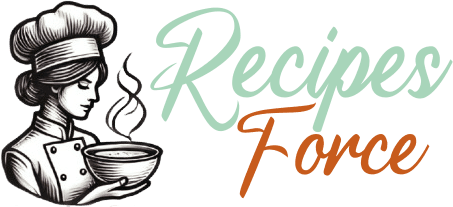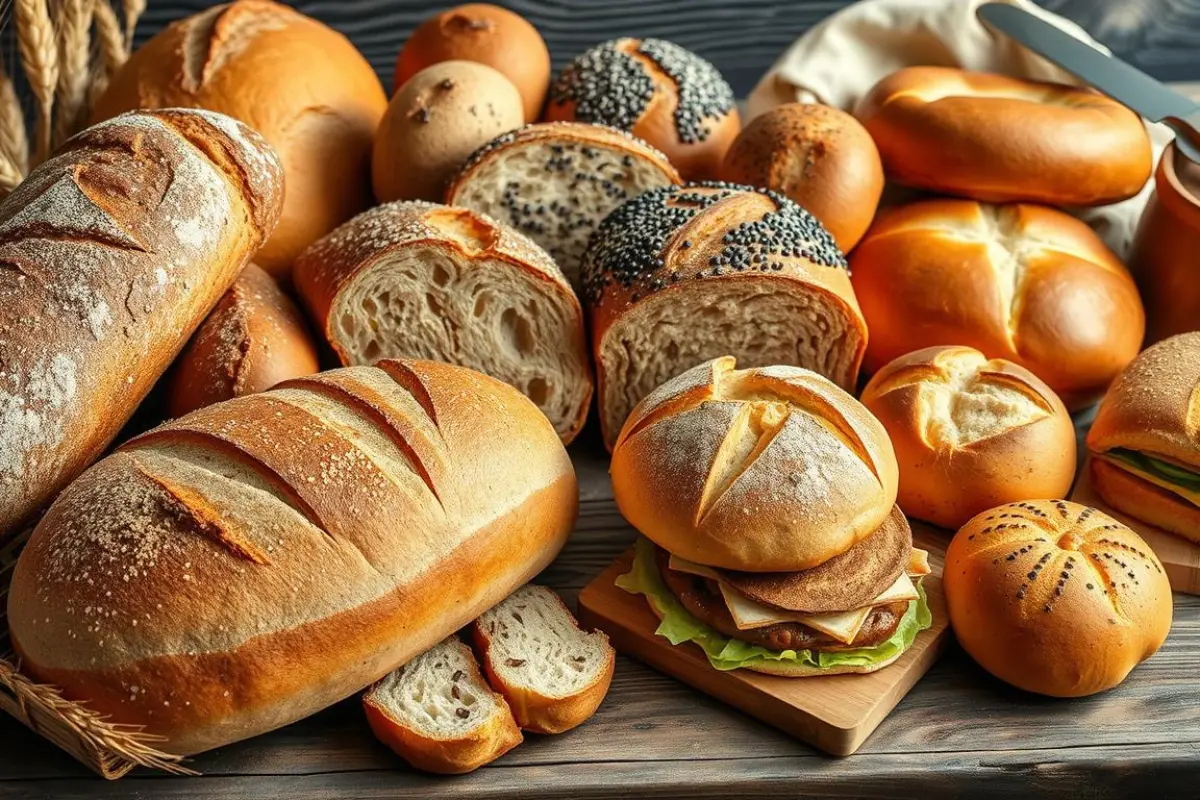What’s the difference between a bun and bread? While both are essential staples in baking, they differ in many ways. Understanding these differences can enhance your cooking, whether you bake at home or simply enjoy these treats.
This guide will explore the history, cultural importance, and main distinctions between buns and bread.
Buns are soft and fluffy, while bread is often crusty. Each has its own special qualities for different dishes. We’ll look at the ingredients, how they’re shaped, and how they’re baked. This will show us what makes buns and bread unique.
Basic Definitions: Understanding Bread and Buns
To understand the differences between types of bread and what is a bun, we need to know their basics. Bread has been a key food for thousands of years. Buns, on the other hand, are a newer type of baked good, often eaten with meals or as snacks.
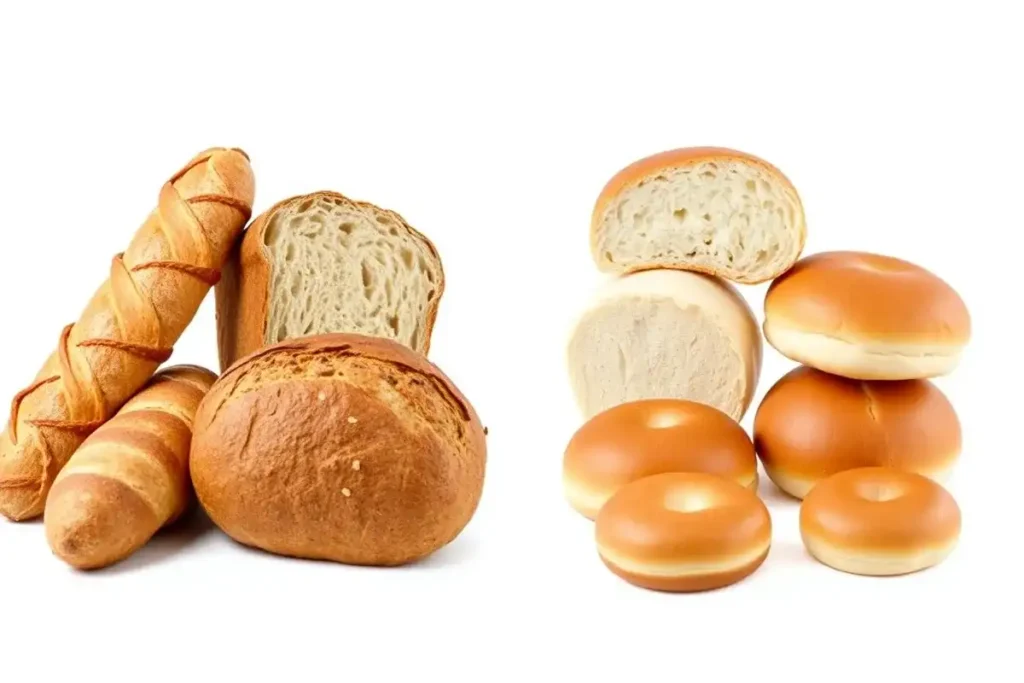
Historical Origins of Bread Making
The history of bread starts in the Neolithic period, when people first grew grains. Ancient Egyptians, Greeks, and Romans all played a part in bread’s evolution. Each added their own twist to this essential food.
Evolution of Buns in Culinary History
The idea of buns came later, with the rise of portable foods. The word “bun” appeared in the late 16th century. Now, buns are everywhere, from hamburger buns to sweet Asian treats.
Cultural Significance Around the World
Bread and buns mean more than just food. They hold deep cultural and traditional values. The French baguette and the challah in Jewish celebrations are examples. These foods carry cultural identity and heritage.
What’s the Difference Between a Bun and Bread?
The terms “bun” and “bread” are often mixed up, causing confusion. But, there are clear differences between them. Let’s look at what makes buns and bread unique.
Buns are smaller and round or oval, while bread comes in many shapes. Typically, buns are round, whereas bread can be found in loaves, rolls, or flatbreads.
The texture of buns is softer due to a higher fat and sugar content, which contributes to a richer taste. In contrast, bread emphasizes the flour, yeast, and water in its dough
Buns are great for sandwiches or burgers. Bread is more versatile, used for toast, sandwiches, soups, and stews.
“Bread roll” and “bread bun” are sometimes used the same way. But, rolls are smaller and more uniform. Buns might look more rustic.
Even though buns and bread are similar, knowing their differences helps in choosing what to eat. It’s all about what you need and like.
Key Characteristics of Traditional Bread
Traditional bread is known for its unique qualities. It includes the choice of types of bread and bread terminology used. The shapes, sizes, and textures also make it special.
Ingredients and Preparation Methods
The base of traditional bread is flour, water, yeast, and salt. Different cultures use unique ingredients and methods. Kneading, proofing, and baking shape the bread.
Common Bread Shapes and Sizes
Traditional bread comes in many shapes and sizes. You’ll find loaves, baguettes, boules, batards, and rolls. These shapes affect the bread’s texture and taste.
Crust and Texture Variations
The crust and interior of traditional bread are key. The types of bread and bread terminology affect the crust’s texture. The crumb can be airy, dense, or chewy, enhancing the taste.
| Bread Type | Crust Texture | Interior Texture |
|---|---|---|
| Sourdough | Crisp and chewy | Soft and airy |
| Whole Wheat | Hearty and nutty | Dense and chewy |
| White Bread | Soft and delicate | Light and fluffy |
Distinctive Features of Buns
What makes bread a bun different from regular bread? Several key features set buns apart. They have a unique shape, texture, and composition.
Shape and Texture
Buns are known for their rounded, slightly flattened shape. They have a soft, pillowy texture. The inside is light and airy, while the outside is crisp.
This shape and texture come from special baking techniques. These are different from those used for traditional bread.
Ingredient Composition
Buns have a different ingredient mix than bread. They often include eggs, butter, sugar, and milk. These add to their soft, slightly sweet flavor and tender crumb.
Intended Use
Buns are used differently than bread. They’re not just for sandwiches. Instead, they’re often served with dishes or as the base for burgers and sliders.
Understanding these features shows that what makes bread a bun is unique. It’s a special type of baked good, with its own defining traits.
Preparation Methods: How Buns Differ from Bread
Bread and buns are both baked goods, but they are made differently. Knowing these differences helps us see why a bread roll is special compared to regular bread.
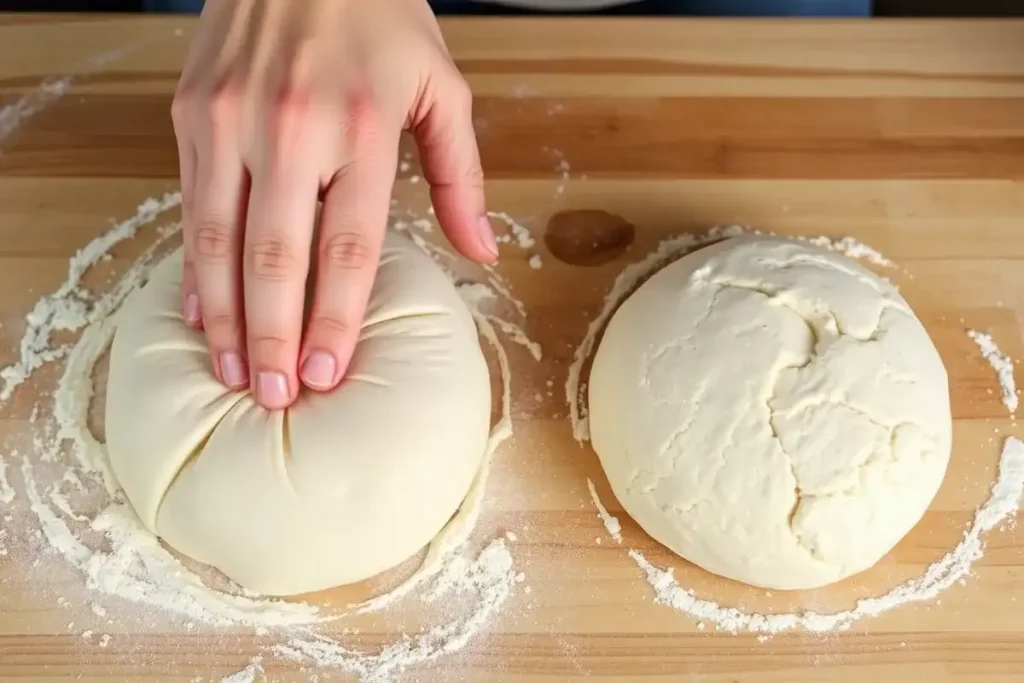
Kneading and Shaping Techniques
Bun dough gets kneaded more than bread dough. This makes the dough stretchy and easy to shape. Bread dough, however, is kneaded less, making it denser and more uniform.
Buns are shaped into round or oblong forms, sometimes with fancy toppings. Bread, on the other hand, sticks to simple shapes like rectangles or ovals.
Baking Temperature and Time Differences
Buns are baked at higher temperatures than bread. They are baked at 400°F to 425°F for 12 to 18 minutes. This makes them soft inside and golden outside. Bread, baked at 350°F to 375°F for 25 to 40 minutes, is more evenly baked.
| Characteristic | Buns | Bread |
|---|---|---|
| Kneading | Intensive kneading for a stretchier, more pliable texture | Shorter kneading duration, resulting in a denser crumb structure |
| Shaping | Round or oblong shapes, sometimes with decorative scoring or toppings | Basic rectangular or oval loaf form |
| Baking Temperature | 400°F to 425°F | 350°F to 375°F |
| Baking Time | 12 to 18 minutes | 25 to 40 minutes |
These differences in making buns and bread make buns unique. They are not just like regular bread.
Common Uses and Applications
Buns and bread are used in many ways in cooking. They are key in making sandwiches and sides for big meals. These baked goods are loved by many at home and in restaurants.
Are buns slices of bread? They are perfect for making sandwiches. From simple grilled cheese to fancy club sandwiches, they offer a great base. Burgers also use buns to keep everything together.
Beyond sandwiches, bread roll varieties are great as sides. Dinner rolls, for example, go well with roasted meats, stews, and casseroles. They add warmth and comfort to any meal.
| Common Uses for Buns | Common Uses for Bread |
|---|---|
| Hamburgers Hot dogs Sliders Breakfast sandwiches | Toast Sandwiches Bread pudding Breadcrumbs |
Whether as a sandwich base or a side, are buns slices of bread? and bread roll varieties are vital in cooking. They play a big role in food traditions worldwide.
Nutritional Comparison Between Buns and Bread
When comparing buns and bread, knowing the nutritional differences is key. Both can fit into a healthy diet, but they have different nutritional profiles. Let’s look at the calories and macronutrients in these two foods.
Caloric Content Analysis
A typical bread slice has about 80-100 calories, depending on its type and size. A standard bun, however, can have 150 to 300 calories. This is because buns often have more sugars, fats, and other ingredients.
This calorie difference is something to think about, especially for those watching their calorie intake.
Protein and Fiber Differences
Bread usually has more protein than buns. Whole-grain and multigrain breads can have 4-5 grams of protein per slice. Buns have 2-3 grams of protein per serving.
Also, bread, especially whole-grain types, has more dietary fiber. This is good for digestion and keeping you full.
| Nutritional Aspect | Bread | Buns |
|---|---|---|
| Calories (per serving) | 80-100 | 150-300 |
| Protein (per serving) | 4-5 grams | 2-3 grams |
| Fiber (per serving) | 2-3 grams | 1-2 grams |
Choosing between buns and bread depends on your dietary preferences and goals. Knowing the nutritional differences helps make choices that support your health and wellness.
Popular Types of Buns Around the World
The bun has a rich history and is loved worldwide. From France’s fluffy brioche to China’s savory mantou, there’s a wide range of flavors and textures. Let’s look at some of the most popular buns from different cultures.
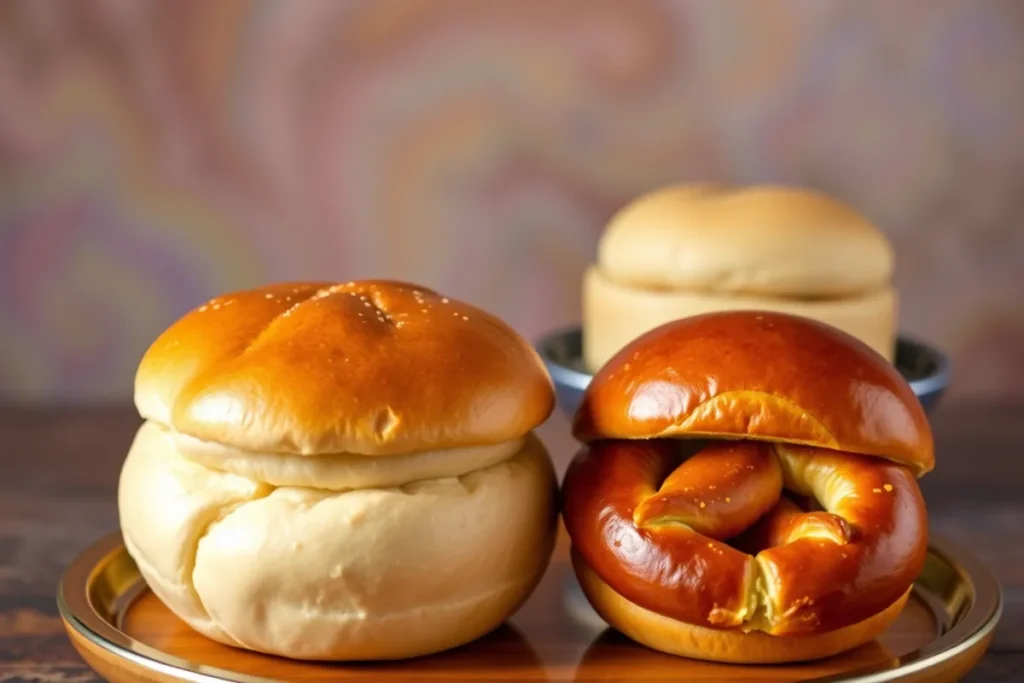
Challah: The Braided Delight of Jewish Cuisine
Challah is a special Jewish bread, known for its braided shape and rich ingredients like eggs and honey. It’s a key part of Jewish celebrations, enjoyed on the Sabbath and holidays. The braids symbolize unity and tradition in the Jewish community.
Bao Buns: The Fluffy Steamed Delicacies of Asia
Bao buns, or mantou, are a favorite in Asia. They’re soft and fluffy, filled with savory or sweet treats like pork or red bean paste. Steaming makes them light and perfect for their fillings.
Hamburger Buns: The Foundation of American Classics
Hamburger buns are essential for American burgers. They’re the base for juicy patties and toppings. You can find them in various sizes and textures, from soft to crispy.
Pretzel Rolls: The Twist on German Tradition
Pretzel rolls come from Germany and are a twist on traditional pretzels. They have a unique shape and chewy texture from a special cooking method. Often seasoned with coarse salt, they add a savory touch to sandwiches or snacks.
The world of bread rolls is a mix of cultures, each bun with its own story. Whether you love the brioche, challah, or pretzel rolls, there’s always something new to try. The variety of buns invites us to explore and enjoy different flavors and textures.
Storage and Shelf Life Differences
When comparing bun vs bread, their storage needs and shelf life differ a lot. Knowing how to store and for how long is key to keeping your bread terminology fresh and tasty.
Proper Storage Methods
Buns are softer and fattier than regular bread. They need more care when stored. Here’s how to keep buns fresh:
- Keep buns in a sealed container or plastic bag at room temperature, away from sunlight or heat.
- Don’t put buns in the fridge. The cold, dry air can make them dry and stale fast.
- To keep buns longer, freeze them in a bag or container. Thaw at room temperature before eating.
Freshness Duration Comparison
Buns usually don’t last as long as bread. Bread can stay fresh for 3-5 days when stored right. But buns might only last 1-2 days before getting stale. The exact time depends on the recipe, ingredients, and how you store them.
Knowing how to store and how long buns and bread last helps keep your baked goods fresh. This way, you can enjoy them longer, whether at home or when serving guests.
Common Misconceptions About Buns and Bread
There are many myths about buns and bread that cause confusion. Let’s look at and clear up some of these common misconceptions.
Myth 1: Buns and bread are the same thing. Buns and bread share some ingredients like flour and yeast. But, they differ in shape, texture, and how they’re made. Buns are smaller, denser, and have a unique crust. Bread, on the other hand, comes in many shapes and sizes with a softer inside.
Myth 2: Bread rolls and buns are interchangeable terms. While people often use these terms together, there are differences. Bread rolls are bigger and more cylindrical. Buns are smaller, rounder, and have a sweeter taste and a distinct crust.
Many think all buns are the same. But, there are many types of buns, each with its own special features. From soft burger buns to chewy pretzel buns, the variety is vast.
| Characteristic | Bread | Buns |
|---|---|---|
| Size | Larger, varying shapes | Smaller, more uniform shape |
| Texture | Softer interior, variable crust | Denser interior, distinct crust |
| Flavor | More neutral, versatile | Often slightly sweeter |
| Preparation | Longer proofing and baking time | Shorter proofing and baking time |
Knowing these differences helps you choose the right bread or bun for your recipes.
When to Choose Buns vs. Bread
Choosing between buns and bread can greatly affect your meal. Each has unique qualities that suit different needs and tastes. Knowing these differences helps you pick the best option for your dishes.
Meal Planning Considerations
Buns are great for burgers, sandwiches, and sliders. They’re soft and support big fillings well. They also work well for small treats like mini sandwiches or dinner rolls.
Traditional bread is better for dishes needing a sturdy base. It’s perfect for soups, stews, and breakfasts. It’s also great for toasting, garlic bread, and open-faced sandwiches.
You May Also Like:
- Grandmothers Clam Chowder Recipe: Perfect for Winter!
- Marks Pizza Sweet Sauce Recipe: 5 Easy Tips for Perfect Flavor
- Longhorn Parmesan Crusted Chicken Recipe: 4 Simple Tricks
Recipe Recommendations
- For burgers and sliders, choose soft, slightly sweet buns that can handle the filling.
- Use hearty bread with soups and stews for a satisfying bite and to soak up flavors.
- Make your breakfast better with artisanal bread toast and your favorite toppings.
- Mini buns are ideal for small appetizers and hors d’oeuvres.
The choice between buns and bread depends on the dish, your taste, and the texture you want. By thinking about these, you can choose the best option for a great meal.
Conclusion
Exploring the differences between buns and bread shows they are close but distinct. Both are made from dough and baked. But, their ingredients, preparation, and uses in cooking are different.
Bread is a key part in many dishes and diets. It comes in various shapes, crusts, and nutritional values. Buns, with their soft texture and sweeter taste, are perfect for burgers, sandwiches, and breakfast.
Knowing the differences helps us make better choices in cooking and meal planning. By understanding buns and bread, we open up new culinary possibilities. This enhances our dining experiences.
Frequently Asked Questions (FAQs)
Are bread and bun the same?
No, they differ in size, texture, and sweetness; bread is a staple while buns are smaller and often sweeter.
What makes bread a bun?
Buns are smaller, round, softer, and may contain extra ingredients like milk or eggs.
What is the difference between a bread roll and a bread bun?
Rolls are larger and crustier, while buns are softer and sweeter, ideal for different dishes.
Are buns slices of bread?
No, buns are distinct baked goods shaped into rounds for sandwiches, unlike sliced bread.
What are the different types of bread?
Types include yeast breads (like white and whole wheat), quick breads (like banana bread), flatbreads (like naan), and specialty breads (like sourdough).
What is the difference between a bun and a bread?
Buns are smaller and softer, while bread is denser and more versatile for various dishes.
What are the different types of bread rolls?
Types include dinner rolls (small and soft), Kaiser rolls (crusty), brioche rolls (buttery), slider buns (mini), hamburger buns (larger), and Parker House rolls (soft).
What is a bun?
A bun is a smaller, often sweet type of bread used for sandwiches with a softer texture.
What are the differences in bread types?
Differences arise from ingredients, preparation methods, and uses, such as yeast breads using yeast and quick breads using baking powder.
